Galloway cattle are domestic cattle known as a beef breed.
They originated in the Galloway region of Scotland, which is how they got their name.
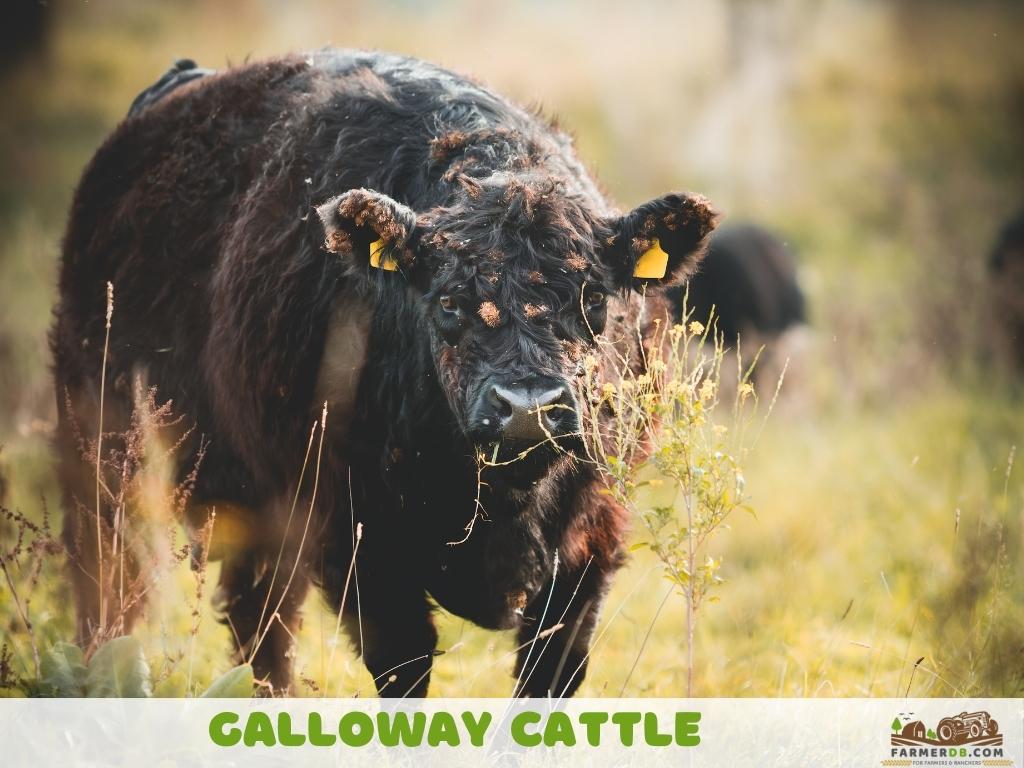
In the United States, Galloway cattle are seen as a rare breed. The American Livestock Conservancy has labeled them as “Recovering,” meaning their numbers are improving but still need attention.
In 2022, there were about 26,800 Galloway cattle worldwide, found in 23 different countries. Most of these cattle are in Northern Europe, especially in Denmark and Germany.
Characteristics
These cattle are known for their distinct appearance and adaptability, making them unlike any other breed. Their strong build, thick coat, and natural resilience reflect their origins in Scotland’s harsh landscapes.
Physical Characteristics
Head
The head is short and square, narrowing at the muzzle.
It is always polled, meaning it has no horns.
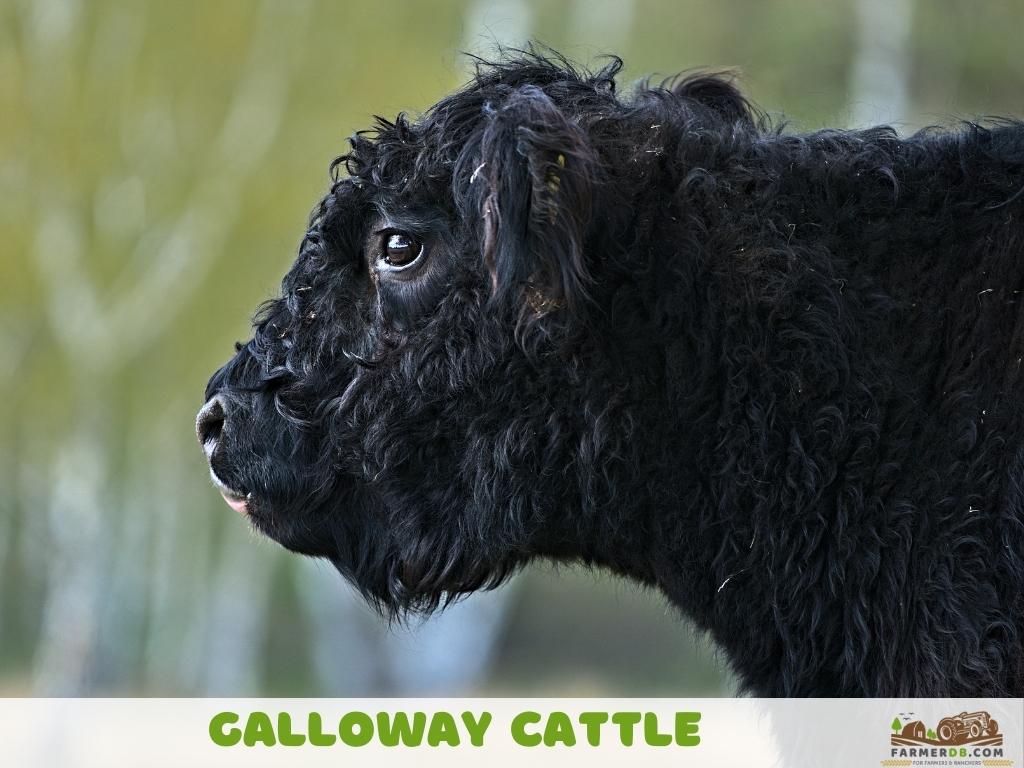
The eyes are lively and alert, giving an impression of sharpness and intelligence.
Neck
The neck has a slight upward curve in bulls, becoming smaller and more refined as it approaches the head.
Body
The body is straight and well-structured, with plenty of room for the lungs, allowing for good health and stamina.
The back is straight from the ears to the rump, broad and level over the kidneys, with no rise at the base of the tail.
The ribs are long, the belly is moderately sized, and the pelvis is large. The flank is full and broad at the top of the loins.
The udder is compact and small, with short teats.
Legs
The legs are short and sturdy, with hind knees straighter compared to many other breeds, giving a balanced and solid stance.
Tail
The tail is short and thick, with a bushy tip covered in hair.
Hide
The hide is thick, providing durability and protection against harsh conditions.
Colors
The breed is predominantly black, but other colors, such as dun (light brown) and red, are also recognized. These solid colors add to the breed’s striking appearance and uniformity.
Coat
The coat is long and shaggy, offering excellent insulation and protection in cold climates.
An important part of their adaptation is their double coat, which develops in the winter.
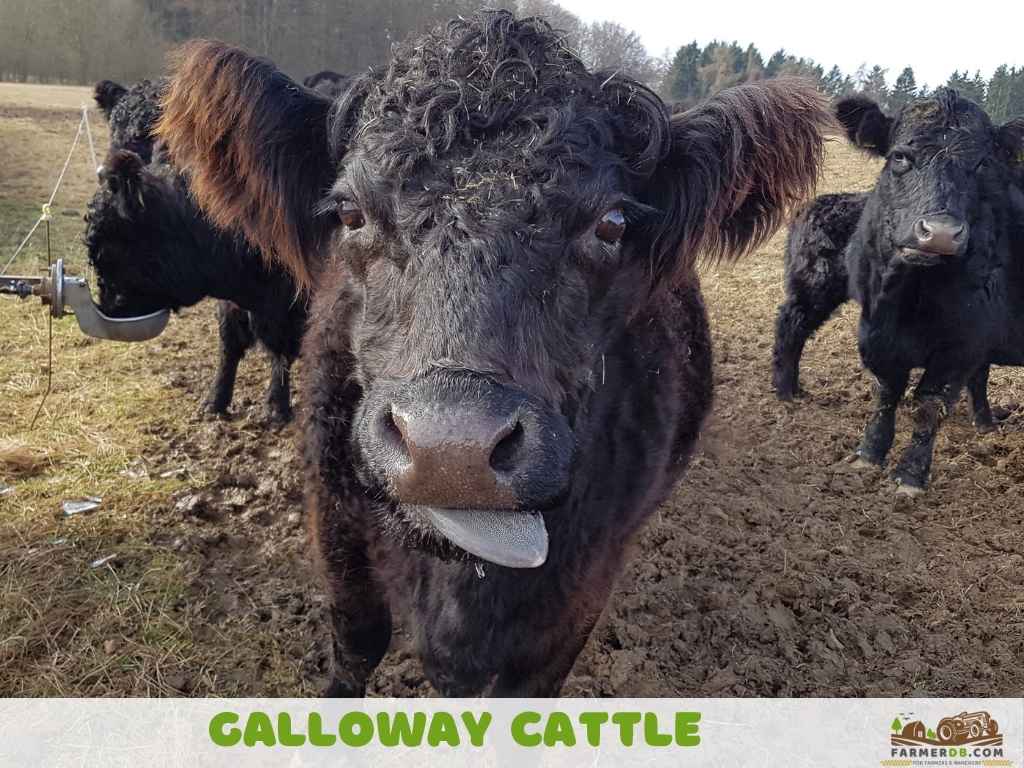
This coat consists of a soft, insulating underlayer and a wavy, water-resistant outer layer. It helps them stay warm in harsh climates, allowing them to graze and remain active even during cold weather.
Size
This cattle is medium-sized.
Cows stand approximately 47 inches (120 cm) at the shoulder, and bulls are taller, reaching about 53 inches (135 cm).
Lifespan
They can live up to 20 years or more.
Their longevity makes them a durable and economically beneficial breed for farmers. They also remain productive well into their late teens and beyond.
Growth Rate
How fast do they grow?
This breed is known for its slower growth rate compared to other beef breeds.
It typically reaches market weight in 24 to 36 months, depending on the quality of feeding and grazing conditions.
Weight
A mature bull typically weighs between 1,700 to 2,300 lbs (770 to 1,050 kg), with an average weight of around 1,800 lbs (820 kg). A mature cow generally weighs between 1,000 to 1,500 lbs (450 to 680 kg), with an average of about 1,250 lbs (570 kg).
Newborn calves usually weigh between 75 to 80 lbs (34 to 36 kg) at birth.
Slaughtered Time
You can slaughter these cattle around 2.5 to 3 years of age, as this is when they typically reach their ideal market weight.
At this point, they often weigh between 1,000 to 1,200 lbs (450 to 550 kg), depending on their diet and grazing conditions.
Although they can technically be slaughtered earlier, waiting until they are around 2.5 to 3 years old allows them to fully mature. This results in better meat marbling and overall higher-quality beef.
Temperament and Behaviour
This breed is calm and gentle, but also brave when needed.
Even though they are easy to handle and friendly, they have a strong instinct to protect their calves. It is said that they will work together to face predators to keep their young safe.
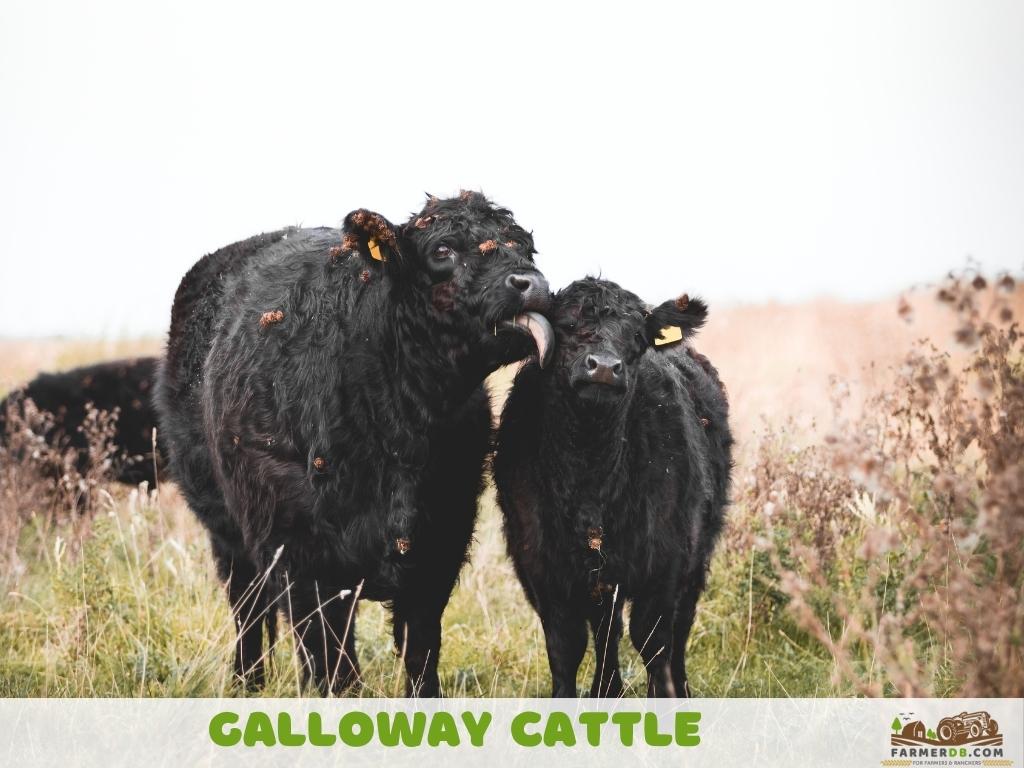
They also show this protective behavior in mixed herds. For example, if only a few of them are in a field with sheep, they will act as guards, making the area safer for the sheep.
These animals are very social and enjoy being in groups.
They are natural grazers, spending much of their time eating grass and adapting well to different types of land, including areas with poor-quality pasture.
Their combination of courage, calmness, and social nature makes them a good choice for farms, especially in areas where predators may be a concern.
Meat
The meat from this breed is well-known for its high quality and special characteristics, making it a popular choice for many markets.
It is naturally lean, with a good balance of marbled fat, which adds juiciness, tenderness, and flavor.
This balance is one of the main reasons beef is seen as premium quality, especially for people looking for grass-fed or organic options.
The texture of the meat is soft and tender, making it easy to cook and enjoyable to eat. Its tenderness stands out, even compared to other breeds, thanks to the natural marbling and the breed’s steady growth rate.
The flavor is rich and full, making the beef ideal for many types of dishes. From classic roasts to high-quality steaks, the taste makes it a favorite among chefs and home cooks alike.
The meat often has a deep red color, which shows it is of good quality.
While this color may not be very different from other high-quality beef, it does give the meat an attractive appearance.
This beef works well for many special dishes, such as steaks, roasts, or gourmet burgers.
The breed’s long body shape means there is a higher amount of premium cuts, which adds value to the meat.
Its combination of lean meat, soft texture, rich flavor, and good appearance makes it a top choice for many people who enjoy high-quality beef.
Milk
Even though this breed is primarily raised for meat production, it can produce 35-40 lbs (about 5 gallons) of milk daily, which is more than most other beef breeds.
The milk is high in butterfat and typically A2 milk, an old-style milk that contains easily digestible protein and low lactose levels.
This makes their milk not only suitable for human consumption but also ideal for making rich butter and cheese.
Raising
Their combination of low-maintenance needs and friendly behavior makes them one of the easiest and most rewarding breeds to raise.
Feeding
You can feed Galloways primarily on grass, as they are incredibly efficient grazers.
There’s no need for grains or high-energy feeds to keep them healthy and in good shape.
During the warm months, you can rely on natural pasture grazing. They thrive on a variety of grasses and can even graze on weeds, rushes, and purple moor grasses, which many other livestock avoid.
This makes them valuable for managing and diversifying grasslands. Their ability to browse means they can also eat shrubs and bushes, adding variety to their diet and helping maintain the land.
In colder months, when grass availability decreases, you can feed them hay or silage as a substitute.
Thanks to their thick, insulating coat, Galloways require 25% less digestible feed to maintain body weight compared to other breeds.
Access to fresh, clean water at all times is also essential for their health and overall performance.
Environment
These cattle thrive best in an outdoor environment where they have ample access to open pastures.
Being natural grazers, they need space to move and forage on grass, weeds, and other vegetation. This outdoor lifestyle not only keeps them healthy but also allows them to utilize their strong grazing and browsing abilities, which are essential for their development.
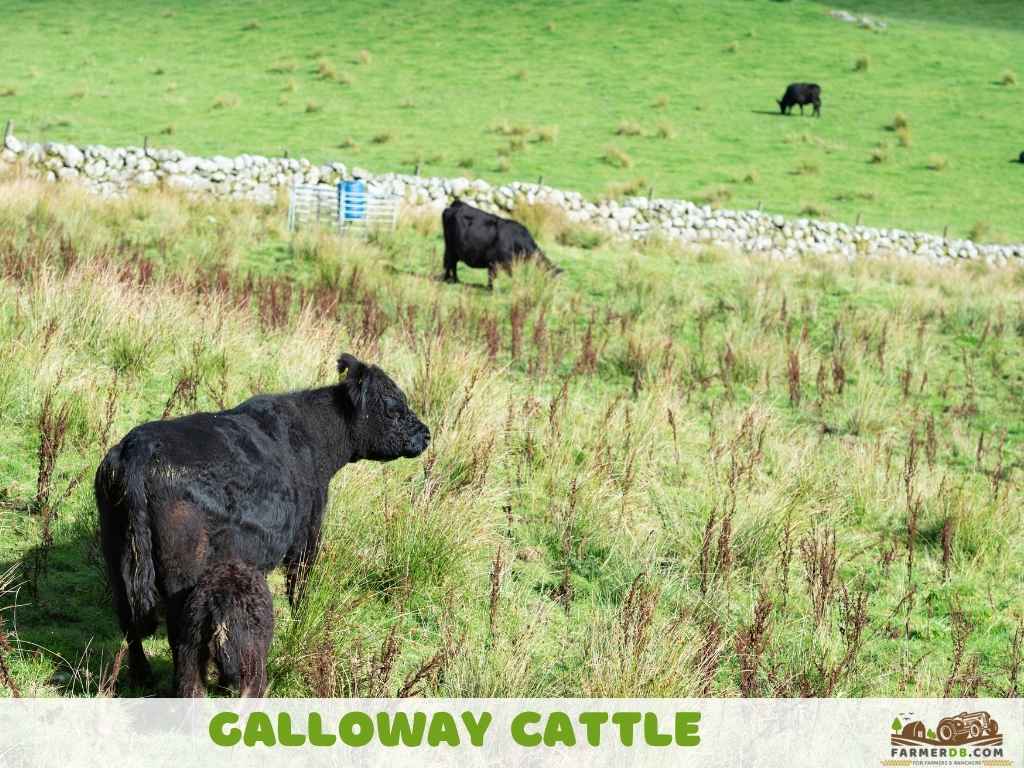
They are not well-suited to being kept indoors for extended periods. When confined, they cannot graze properly, which can negatively affect their growth, health, and overall well-being.
Climate
These cattle are best suited to cool or chilly climates, as they were originally developed in regions with harsh winters.
Their thick double coat provides excellent insulation, allowing them to thrive in cold weather, even when grazing on rough pastures. This natural adaptation makes them ideal for areas with low temperatures, frequent frost, or even snow.
They can adapt to warmer climates if managed properly. During hot weather, they may shed some of their thick coat to stay comfortable, but they will require certain adjustments to ensure their well-being like shelter.
Shelter
They do not need shelter or bedding in harsh weather.
Their thick, water-resistant outer layer and insulating undercoat keep them warm and dry, even in snow and frost.
However, while they may not require a shelter during winter, it’s still a good idea to provide one. A simple shelter can offer them a break from extreme weather like heavy rain, strong winds, or severe storms, ensuring their comfort and reducing stress.
In warmer climates, shelter becomes more important.
These cattle are not naturally adapted to hot conditions, so having a shaded area is essential to prevent heat stress.
A shelter, shade trees, or even a structure with an open design for ventilation can help them cool down during the hottest parts of the day.
How many cattle per acre?
You need at least 3 acres to raise a single Galloway cattle.
Since they are natural grazers, they need enough pasture to provide a consistent supply of grass throughout the year.
Keep in mind that the exact amount of land depends on factors like the quality of the grass, the climate, and how well the pasture grows.
Breeding
You can start breeding cows when they reach 17 to 20 months of age, as this is when they typically reach sexual maturity.
While they can technically be bred at this age, it’s better to wait until they are closer to 2 years old to ensure they are fully developed and healthy.
You can breed them naturally using a bull while the cow shows signs of heat.
The cow is in heat every 21 days and last for about 12 to 18 hours. Common signs of heat include restlessness, attempts to mount other cows, or standing still when another cow tries to mount her.
The gestation period lasts about 9 months (approximately 283 days). This breed typically gives birth with little to no assistance, as they are known for having easy calving due to their natural build and manageable calf size. Most cows give birth to one calf at a time, though twins are rare.
You will find that they are excellent mothers. They are protective of their calves and produce enough milk to feed them.
A cow can be bred multiple times in her life, often producing calves until she is 15 to 18 years old.
Health Issues
Galloway cattle are known for their hardiness and robust health. They are less prone to diseases compared to other breeds.
Why should you raise it?
If you are a homesteader or a small-scale farmer, this breed could be a great choice for you: easy to manage and cost-efficient.
- Minimal feeding needs. You don’t have to worry about daily supplemental feeding.
- No special shelter is required. Unlike some other breeds, they don’t need elaborate shelters or bedding.
- These cattle rarely get sick, which means fewer veterinary visits and lower overall costs.
The only thing to consider is that you’ll need a large pasture with good-quality forage.
Advantages and Disadvantages
Advantages
- Hardy and resilient, able to thrive in cold climates.
- Good foragers and can graze on a variety of grasses and forages.
- Low maintenance and require minimal intervention for breeding and care.
- Produce high-quality meat with a rich flavor.
- Excellent mothers, highly protective and attentive to their calves.
- Calm and friendly temperament, making them easier to handle.
- Prolific breeders, remaining productive well into old age.
- Produce more milk than most other beef breeds, making it ideal for calves and even human use (butter, cheese).
Disadvantages
- Can struggle with heat stress in warmer climates due to thick coats.
- Slow growth rate compared to other breeds.
- Can be harder to find in large numbers for commercial farming.
- Need more space than some breeds due to their grazing habits (2-3 acres per animal).
Contents
Do you have any experience with the topic discussed here?
Would you like to improve the information shared and contribute your practical knowledge on the subject?
Your real-world experience as a farmer or rancher could greatly benefit other members, and the community would deeply appreciate your contribution.

